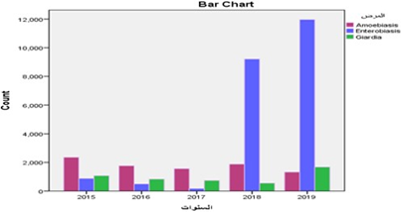Abstract
The increased incidence of the parasites is associated with various factors, including lack of community health awareness, unsafe, inadequate disposal of human waste, lack of safe drinking water, low socioeconomic status, and health system performance. To determine the prevalence of some endemic parasites such as intestinal parasites five years ago, so the study take protozoa parasite Giardia lamblia, Entamoeba histolytica, and one intestinal helminth pinworm Enterobius vermicularis (pinworm) and the correlation of infections with age and sex in Karbala city. This study took cases examined in hospitals and health centers of the districts and the centre of the holy city of Karbala using the database of the Ministry of Health’s Transitional Diseases Centre. It was conducted between 2015 and 2019 to study the efficiency of a health system and the levels of risky infectious diseases. Between 2015 and 2019, the conducted study was on three intestinal parasitic diseases. The study showed a significant difference in the level of infection with pinworm parasites. Infection of Enterobius vermicular increased by 32.8% in 2019 compared to previous years. In the meanwhile, Giardia lamblia decreased by 4.6%, followed by Endameba histolytic a by 3.6%, while the incidence of tissue amoeba parasites increased in 2015, followed by pinworms 2.4% and G.lamblia 2.9%. The study showed a significant difference. The studies also recorded a significant increase in the age group. Some of them were between the ages of more than one year and up to less than 45 years. This difference may be due to variation in sample size, seasonal variation, gene amebiasis, giardiasis, pinworm, parasite ral and personal hygiene, and public health services.
Full text article
Authors

This work is licensed under a Creative Commons Attribution-NonCommercial-NoDerivatives 4.0 International License.

